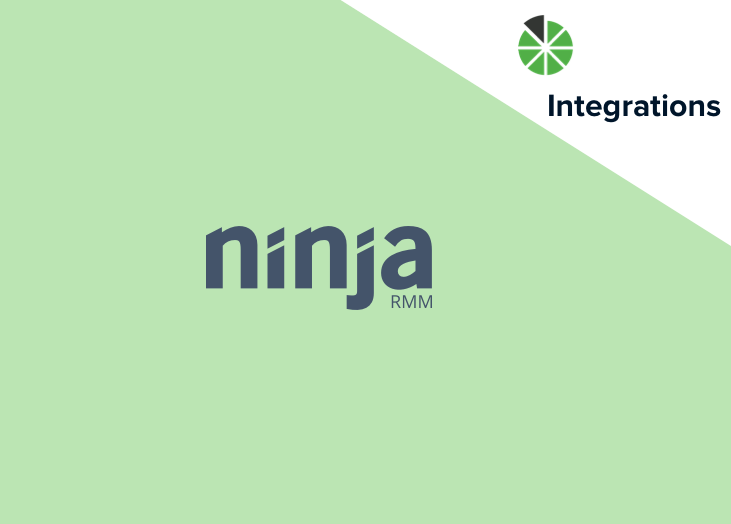Transparency in business is more than just a corporate buzzword, it’s a crucial tactic for earning client trust. Client reports help managed service providers (MSPs) build transparency with their ...
Transparency in business is more than just a corporate buzzword, it’s a crucial tactic for earning client trust. Client reports help managed service providers (MSPs) build transparency with their customers by sharing vital data points on a regular basis—ensuring that the client is kept aware of important developments with whatever services the MSP is providing. Why does transparency matter in business? How can you create transparency with reporting automation? Why transparency in business is essential Transparency, or the ability to make clients feel as though you’re not hiding anything, is a critical trust-building tactic for any business. Without transparency, your business is a faceless entity—one that is readily replaceable. Giving customers insight into your processes and results helps to demonstrate the value of what you do. It can also help to explain any setbacks that may impact your service level agreements (SLAs) or results. This can be crucial for maintaining a positive relationship with clients even when things aren’t always going right. For example, ask yourself this: Have you ever had a problem with a service, but couldn’t get an answer out of your service provider about why there was a problem or how they planned to fix it? How frustrating was that experience for you? Now, what do you think your own clients feel if they can’t get a status update or an answer about an issue from you? Forbes notes that one of the benefits of transparency is that it can help improve profitability. According to their article, “polls through the years indicate at least two-thirds of consumers would spend more if it meant buying from a transparent company. A stunning 94 percent rank transparency as the greatest factor in brand loyalty.” In other words, clients are willing to spend more for the peace of mind of dealing with a transparent partner and are more likely to stay long-term when they feel they’re being given the whole picture. 5 ways to increase transparency through client reporting So, how can you use client reporting to create transparency in business settings? Here are a few tips to get you started: Focus on the metrics that are most important to the client. While giving the client a report that has every possible key performance indicator (KPI) on it can provide value, it can also be overwhelming. Consider which performance metrics actually matter to your client based on their goals and their role and create a list of the ones that make the most sense to report on. Creating a “data dashboard” view of the client’s most important metrics to go on the first page of the report can make it easier for them to find the info they want so they can avoid wasting time going through a massive pile of statistics with every report. Use Reporting Automation. Manually compiling client reports can be a major time sink—especially if you have to gather data from multiple sources and compile it into a digestible format. Client reporting software can help to automate this task. Using a client reporting solution that can draw data from multiple sources to automatically populate a report with the appropriate metrics can save hours of time on each report and increase transparency by ensuring that each report is consistent. Customize client reports for different stakeholders on the client side. Odds are that there are multiple decision-makers or VIPs in the client’s organization that may need to see the data in your client reports. However, not all of them may need to know the exact same things. Identifying the key stakeholders who need to see your reports, verifying the specific KPIs that matter to them, and creating custom reports that address their biggest concerns with a simple KPI dashboard view can all help to massively increase transparency with your customers. Additionally, it helps demonstrate the ROI for your services to multiple decision-makers (which can be important for when the client is internally reviewing whether to retain your services moving forward). Regularly communicate with the client outside of your reports. While client reporting is important for building transparency, these reports shouldn’t be your only communication channel with clients! It’s important to speak with clients outside of these reports to get updates about new initiatives they may be launching or changes in how they evaluate success in their organization. This can help keep you updated about important changes in the client’s organization that may mean needing to track different KPI dashboards in your client reports. Keep reports consistent (unless a major change is needed or requested). From one reporting cycle to the next, it’s important to keep the reports you send to the client as consistent as possible. Keeping your report format consistent from one report to the next helps make it easier to parse for your clients because they’ll know exactly where to look for the info they want. Short of a major change or a client request, it’s best to be as consistent as possible with client reporting formats (using reporting automation and other tools can help with this)! Boost transparency with BrightGauge’s client reporting tools Do you want to transform your client reporting process in a way that makes things faster, easier, and more consistent? If so, BrightGauge’s client reporting tools can help make you more transparent. With BrightGauge, you can easily create custom client reports using a drag-and-drop editing tool that gives you complete control over what data the report contains and where that information appears. Data for each report can be automatically pulled in to populate the KPI dashboard and individual data points throughout the report. BrightGauge’s reporting automation tools also allow you to schedule repeated automatic reports. Instead of having to set up each report and manually email it out to every client, you can set up a regular report once and let BrightGauge send an updated report each week, month, or quarter as needed to meet your reporting SLAs. This can be a huge time-saver for anyone who has to send a lot of client reports! Are you ready to transform your client reporting and build transparency? Reach out to BrightGauge today to get started!

In the era of remote work, how are you bringing your team members together and keeping them focused? Many of our partners swear by using goals to combat this challenge. Goal-setting is an effective and proven way to align team members and keep everyone marching down the same path. Maybe you're familiar with Gino Wickman's book Traction, which introduces the Entrepreneurial Operations System (EOS), a process many managed service providers (MSPs) use to grow and optimize their business. By setting goals, whether through EOS or another process, you're creating a culture of accountability that can have a really positive impact on your business. Implementing a goal-setting system is an excellent place to start, but how are you having conversations around those goals with your whole team? This month's report, a Goals and EOS Tracking Weekly Report, is a great way to move forward. Goals and EOS Tracking Weekly Report - view here This report can be used as a weekly check-in for operations meetings. It structures the meeting so the conversation is guided towards where the team stands with their goals, what's being done to meet their core values, what tasks/projects are currently open, what's overdue, and what known issues need to be addressed. Having this weekly check-in where every team member is responsible for playing their part can have a huge impact on how productive, efficient, and overall happy your team members are. To recreate this report for your own team, check out the links below: Goals and EOS Tracking Weekly Report (Public view link) Goals and EOS Tracking Weekly Report Buildout Key Please feel free to reach out to success@brightgauge.com with any questions you have!

Employee engagement continues to be a key driving force for meeting business goals in all industries. However, even during the record-high employee engagement rates reported by Gallup in April of 2020, less than half (38%) of all employees were engaged with their work. Also, shortly after that record high, Gallup reported a record drop in engagement of 7%. This drop brought the ratio of engaged employees to slightly less than one in three (31%). There are many factors that go into employee engagement and inspiration—from manager attitudes and behaviors to career growth opportunities, job stability, work expectations, and more. Keeping employees inspired to do their best work can be a major challenge. However, it can be well worth it! As noted in research cited by Forbes, “engaged teams have lower turnover, 21% greater profitability, 17% higher productivity and 10% higher customer ratings than disengaged employees.” For sales teams, goal management can be a key driver for employee engagement. So, in today’s post, let’s discuss how you can use goal setting to inspire sales teams to go the extra mile and increase results. How to set sales goals that drive more revenue for your business When setting employee goals for sales team members to meet, it can be helpful to follow a few basic best practices: 1: Keep goal timeframes short (or break larger ones into more digestible chunks) While annual goals are important for the company as a whole to meet, pushing annual sales team goals into a sales rep’s face at the start of the year can be intimidating. For example, in another blog, when we told one of our sales reps that “his quota had almost doubled to $80,000 after last year doing $45,000 he had a minor panic attack.” This is a natural enough of a reaction to being told to do nearly twice as much as before, and the big goal was a little intimidating. However, we broke that big annual goal into much smaller and more manageable daily and weekly goals like “10 opportunities opened per week” or “40 conversations per week” that provided a short-term goal to focus on. This way, instead of worrying about a massive end-of-year goal that might feel impossible to meet, all he had to worry about were smaller weekly process and outcome goals that all contributed to keeping him on track for that big end-of-year outcome goal. 2: Benchmark sales goals against past performance An important part of the SMART (specific, measurable, achievable, relevant, and timely) goal setting framework is that a goal must be achievable for it to motivate people to work for them. But, how can you determine what is or isn’t achievable? One way to ensure that your sales team goals are achievable is to take a look at past performance and use that data as a benchmark for future performance. This can help you set goals that are aggressive, but realistic. 3: Create accurate estimates of how long sales tasks should take before setting task-based goals How long does it take for a sales team member to complete a successful prospect call? How long is the average failed call? When setting process goals for sales people that ask them to complete “X” actions in a day, the time it takes to complete the specified task can have a huge impact on whether that goal is or isn’t achievable. For example, if you set a goal of “make 20 prospect calls a day,” and each call takes half an hour on average, there is no way that a sales rep will be able to meet their goal, as that’s ten hours of calls to make in an eight-hour shift. Additionally, it’s important to leave room for some downtime between calls so the sales rep can recover mentally, take care of other tasks, and prepare for the next call. So, a goal of 12-14 calls per day might be more realistic when the average time per call is 30 minutes. This works to keep sales reps motivated so they sell more rather than give up (or try to cut corners to save some time to meet an impossible activity goal). 4: Use a goal tracking solution that provides a public data dashboard When setting goals for sales teams, it’s important to make sure that the reps on those teams know what their goals are at all times—as well as how they and their colleagues are tracking towards those goals. Public data dashboards can be an invaluable tool for accomplishing this. With a public dashboard displaying each sales rep’s key performance indicators (KPIs), you can ensure everyone knows how well they’re progressing towards their goals—and even encourage some healthy competition as salespeople try to one-up each other on the “leaderboard.” The 3 sales goals you should be tracking Which sales goals should you be tracking to encourage business growth? Here’s a brief look at the top three sales KPIs your team should be tracking: 1. Closed monthly recurring revenue (MRR) for the current month and year to date For managed service providers (MSPs) that thrive on providing consistent services from month-to-month, tracking MRR is a no-brainer. Your closed MRR will tell you how well your team is selling (and how well client services is doing at retaining customers) so you can identify trends over time. Being able to track MRR on a monthly and year-to-date basis helps you identify ebbs and flows in your sales over the course of a year—making seasonal trends clearer so you can set better goals and targets based on your company’s “busy” and “slow” periods. It can also help you determine if your company is or isn’t growing. 2. Current sales pipeline How many opportunities are in your company’s sales pipeline at any given time? Your sales team should never be without prospects to call or leads to follow up with. Your current sales pipeline is a measure of how many opportunities/leads are in your sales process at any given time—which can help you estimate the number of new customers your business can expect to gain. A closely-related statistic that may be worth tracking is sales attrition rate—the number of opportunities/leads that leave your sales process without successfully closing a deal for one reason or another. If there is a high attrition rate at a specific step of the sales process, then that could indicate an issue that needs fixing. 3. Sales activity goals A successful sales process typically involves engaging in certain activities a set number of times—such as making calls, setting up demos, and using specific sales-generating strategies. These sales process goals help to ensure that sales team members are engaging in the key activities needed to drive success and results. However, process goals alone may not be enough. Sales reps should also be held accountable to meet outcome goals—after all, anyone can make 20 calls a day if they aren’t putting in the time and effort to make a sale. With outcome-focused sales activity goals, like “sign X new customers” or “generate $6,000 in net new sales each month,” sales reps can be motivated to do more than just go through the motions. Being held accountable for results and process goals gives them a roadmap of what they need to achieve and how they can achieve it. Set and monitor the right sales goals through BrightGauge’s goal management dashboards Whether you’re tracking sales goals for a whole team or for individual sales reps, BrightGauge is here to help! We make tracking metrics like closed MRR, current sales pipeline, and sales activities quick and easy. BrightGauge’s public data dashboards let your sales reps see their numbers at a glance, letting them know which KPIs they need to focus on to meet their personal sales goals. These dashboards are also a handy tool for one-on-one meetings with employees that give managers a convenient look at an employee’s actual performance to date. Also, if the goals you need to track change because of a new initiative, BrightGauge makes it easy to modify the information displayed in the dashboard. With numerous integrations for different data sources, BrightGauge is easy to incorporate into your business. Are you ready to transform your sales team performance tracking? Reach out to the BrightGauge team today!

Talent acquisition and management is a constant challenge for any organization. Of particular concern is keeping the employees you’ve spent so much time, money, and energy recruiting and training with your company. Employee churn, employee turnover, employee attrition—whatever you call it, losing an employee you’ve spent time and other resources on building up to be part of your organization can hurt your bottom line. What is employee churn rate? What is the cost of employee turnover? How can you prevent employees from leaving? What is employee churn rate? A company’s employee churn rate is a measure of how many employees leave the company in a given period of time. This metric is often expressed as a percentage. For example, if a company has 150 employees, and 15 of them leave in a month, the employee churn rate would be 10% for that month. One of the challenges of dealing with employee turnover is that it can be variable by industry and job role. Some jobs, like working in a call center, have numerous stress factors that contribute to employee churn. The hidden costs of employee churn What is the cost of employee churn? The answer varies depending on the employee in question and other factors. Studies cited by organizations like Peoplekeep “predict that every time a business replaces a salaried employee, it costs 6 to 9 months’ salary on average.” In other words, if an employee making $90k a year decides to quit, it could cost between $45k and $60k to replace them. While the “6 to 9 months’ salary” figure might seem a little high at first glance, there are numerous costs associated with replacing an employee. In fact, for some roles, the potential impact of the hidden costs of high employee churn could be even more dramatic. Aside from direct costs like marketing a job opening, onboarding the new employee, and providing training (and pay during said training), there are also hidden costs to consider, like: Lost productivity. Unfortunately, an employee’s departure doesn’t make all of the work they were responsible for go away. In many cases, the loss of an employee, especially one with hard-to-replace skills, means a significant loss of productivity. If an employee is the only person in the organization with a particular skill or knowledge set, then all of the work they were responsible for may grind to a halt until a suitable replacement is found. Even if there are other people with similar skills, taking on the workload of a missing employee on top of their own will still result in delays. This lost productivity can have a direct negative impact on your bottom line. Lost customers. For some employees and job roles (such as sales), losing the employee could mean losing access to their list of clients or the relationships that they had built up with customers. Even with a no-compete clause, there’s always the risk of customers leaving if their preferred team members leave the company. Additionally, a new hire might make mistakes that the old employee would not have—souring the customer experience and costing the company business. Negative workplace culture. One of the potential impacts of a high employee churn rate is that it could create a hostile workplace culture—one that can impact both productivity and worker health. As noted by Quartz, “Studies find that workers who fear being laid off are less safety-conscious, more likely to get injured, and less likely to report injuries.” Employees who have issues with job insecurity (from frequent layoffs, poorly-structured stacked ranking systems, and other issues) are also more likely to engage in reckless or questionable behaviors that cause problems for the organization. High churn rates can contribute to a hostile work environment that leaves employees feeling disengaged and makes people even more likely to quit. Where the direct costs of employee turnover, such as training, marketing open positions, and onboarding employees are relatively easy to calculate, the hidden costs can be more difficult to prove without really good analytics and data. For example, one way to estimate lost productivity would be to compare the new hire’s performance against key performance indicator (KPI) benchmarks set by their predecessor. This could provide a rough idea of the lost productivity caused by the loss of the original employee. A KPI tracking tool would be ideal for this. 6 ways to avoid the costs of employee churn So, how can you avoid the costs of high employee churn? Here are a few ideas: 1. Look for common issues that may cause employee churn. The most direct way to prevent the cost of high employee turnover is to prevent said turnover in the first place. A good starting point for this process is to try to identify common factors between each of the employees that left the company. For example, did the majority of them work in the same department or have the same direct report? Were they putting in a large amount of overtime? Were their KPI goals specific, measurable, achievable, relevant, and timely? If many ex-employees have something in common, then that thing could be the cause of the high turnover rate. By identifying such issues, you can take steps to resolve them and (hopefully) prevent future employee attrition. 2. Check out what other companies in your industry are doing. What are your competitors doing to keep their employees? Are they doing anything to retain their top talents? You can check what others in your industry are doing to keep their best people then use that information to one-up them—either by offering an improved version of the same benefits or by covering gaps that they don’t address. This can help motivate employees to stay with your company. 3. Weed out the “bad eggs” fast. It may sound counterintuitive, but being able to quickly fire a bad employee can be crucial for reducing overall employee churn. Why? As noted in an article feature on Inc.com, “if someone is not carrying their weight without consequence it sends a negative message to the other employees.” Bad employees can negatively impact your corporate culture and lead to more widespread disengagement. If an employee is actively malicious towards their coworkers, then they may make good employees leave. Plus, by eliminating bad fit workers quickly, you can minimize the disruption and resource waste they cause by leaving. 4. Offer opportunities for employees to change roles or advance. One way to keep employees (and attract high-quality talent) is to focus on providing career development opportunities. Basically, this means offering to help employees learn new job skills so they can be promoted or move laterally into a new role if they want to try something different. This can help to keep employees motivated and engaged with their work. Additionally, it can reduce churn by giving employees who would otherwise leave to discover new career opportunities a chance to try something new without having to change employers. 5. Revise your recruitment and onboarding processes. How does your organization currently handle attracting new employees and getting them up to speed? Are there issues in the onboarding or recruitment process that might be giving potential hires the wrong impression about the work? Are the people being attracted through your current recruitment efforts a good fit for your company’s culture? Reviewing your current recruitment and onboarding process to make sure that it helps set the right expectations of new hires (and attracts the right people) can be critical for reducing employee turnover in the long run. After all, if you hire someone and their expectation is to work 9 to 5 as a software developer, but is expected to work 8 to 6 and do copywriting, graphic design, and business process optimization, they may quit in frustration if they weren’t prepared for the actual expectations of the job. 6. Provide ample recognition for major accomplishments It can be frustrating for employees to work hard to accomplish things, only to not receive any recognition or rewards when their efforts go above and beyond what’s expected of them. Employees who routinely exceed their goals may stop trying so hard after weeks, months, or years of not getting recognition for their results. Being able to track what employees are doing and rewarding those who exceed expectations can be an effective way to increase engagement and retain top talents—and saying “thank you” to a hard-working employee doesn’t cost a thing! This is why providing recognition is a goal management best practice. Are you ready to reduce your employee churn rate with BrightGauge? What does BrightGauge have to do with reducing employee churn in your organization? Using goal setting and management tools like BrightGauge can play a key role in your employee recognition and retention efforts! By using a KPI dashboard and tracking tool, you can easily monitor which employees are going the extra mile to deliver results. This, in turn, makes it easy to provide recognition for people who are generating genuine results. Additionally, by tracking KPIs for everyone in a given job role and taking a close look at the results, you can more easily identify goals that need revision. For example, if 98% of all sales reps in your organization are failing to meet a goal like “close 25 deals worth $10k each in a week,” then you might need to revisit that goal and make it more realistic. On the other hand, if everyone is meeting that goal with room to spare, then you might need to make it more aggressive. By accurately documenting real performance and process metrics with BrightGauge, you can show employees where they need to improve in greater detail. This can help with your performance improvement plan (PIP) creation so you can improve productivity without having to onboard a new employee from scratch. Are you ready to step up your employee retention and performance management? Reach out to the BrightGauge team today!

Tracking key performance indicators (KPIs) is a long-proven tactic for improving employee productivity. Using tools such as data dashboards, companies have motivated their employees to achieve greater results with more consistency, which has helped them with enterprise growth. Why should your organization use KPI dashboards? Which business KPIs will help with your enterprise growth? Why growing enterprises should leverage KPI dashboards Growing enterprises often have numerous business objectives that they need to track—and not a lot of time to manually manage that data! KPI data dashboards help to simplify tracking and managing employee KPIs and business KPIs so leaders can check performance with a glance. Instead of having to dig through several separate reports to track all of an employee’s or business unit’s performance metrics, leaders can simply take a look at a data dashboard to get the most relevant and important information in seconds. This information is also easy to collect for reports to key stakeholders who may need it. With easy access to performance data, enterprises can identify trends (both positive and negative) and make changes to account for them. For example, if employees are struggling to meet a particular performance goal, it may be necessary to provide coaching to ensure employees have the skills they need to perform. What business KPIs should you track to boost enterprise growth? Many business owners, leaders, and stakeholders want to know which business KPIs they should track to improve their enterprise growth. The problem is that there is no true “one size fits all” solution when it comes to KPI tracking. Different enterprises will need to track different things to achieve the best growth results. It takes an understanding of your business’ objectives and industry to determine the best KPI dashboards to use in your organization. Additionally, the KPIs you track for one business unit might not be a good fit for others in your company. Here are a few KPI examples to consider when choosing performance metrics to track in your organization: Project KPIs These are KPIs specific to a particular project that is going on. Two important project KPIs to consider include: Billable project hours. A measure of how many hours are spent on a given project in a set time frame. Managed service providers (MSPs) may use this metric to determine if they’re over-billing for a project (potentially indicating that they under-scoped the project). Overbudget projects. How many projects are currently over-budget? This metric can help provide an assessment of how well the company is managing its budget for projects and create early indications of issues that may cause the balance book to go into the red. Customer service KPIs KPIs related to how customers are being serviced. Customer service KPIs can help MSPs and other organizations determine if they’re meeting their service level agreements (SLAs) or if they need to make changes. Some customer service KPI examples include: Time to resolution. How long it takes for a service ticket or customer call to be resolved. This is often used to measure employee performance. Tickets/Cases closed each day. How many client/customer calls or tickets are resolved in a day? Measuring this can help identify potential problems with resolving customer service cases in the enterprise that need resolution. Customer complaint rate. The number of customers who have reached out to make a complaint about a product or service received versus the total number of customers. High complaint rates may indicate a major issue with a given product or service (or how it’s marketed) that needs to be fixed. Financial KPIs Every enterprise needs to carefully track and manage its financial performance data. Having the right financial KPIs can help business leaders anticipate their expenses, avoid potential over- and under-budgeting for key initiatives, and set expectations. Some financial KPIs to track for enterprise growth include: Past due receivables amount. Also called “accounts receivable,” the past due amount is an important metric to track so you can know how much payment to expect from clients. Tracking which accounts are past due is also important for reconciling payments with your clients. Earnings before interest, taxes, depreciation, and amortization (EBITDA). This metric is useful for determining your organization’s financial health. Numerous companies have used this metric to determine employee bonuses for the year. Gross margin per client. A measure of your company’s total revenue minus its direct costs (licenses, software, etc.) and fully loaded labor cost, which is then divided by total revenue to generate the gross margin percentage. Here’s the formula: (Total revenue – direct costs – fully loaded labor costs) / total revenue = gross profit margin. Marketing KPIs Marketing is an important activity for making sure your enterprise’s brand gets in front of potential clients/customers. Marketing KPIs help enterprises establish the ROI of their marketing efforts, determine what is and isn’t working for their marketing, and identify issues that might be causing potential customers to leave the sales funnel. Some marketing KPI examples to track include: Cost per lead. A measure of how much money is spent on marketing to generate a single lead. Calculated by dividing total marketing spend by the number of leads generated. Customer lifetime value. A measure of how much a single customer is worth to your company over their lifetime. Useful for determining how much should be spent on marketing for each customer. Email deliverability. This is the number of emails sent successfully versus those that fail to be delivered or get sent to the spam folder. Failed deliveries can negatively impact your enterprise’s ability to send emails in the future, so this is an important metric for marketing leads to know. Drive enterprise growth with BrightGauge’s comprehensive KPI dashboards While the KPI example list shown above is far from comprehensive, it should provide a rough idea of how many different KPIs there are for companies to track. How can you track so many disparate business KPIs? BrightGauge’s KPI dashboards are one way to track numerous metrics at a glance! With BrightGauge, you can easily customize a data dashboard to present the most important metrics for your business unit or your company as a whole. Instead of digging through a dozen different data sources and apps, you can have BrightGauge collect everything you need to know into a single-pane view that is easy to parse. Are you ready to get the data you need to fuel your enterprise’s growth? Reach out to the BrightGauge team today!

70+ Metrics for MSPs
Key metrics and accompanying formulas to help MSPs skyrocket growth and success!
Get your KPIs

This one's been a long time coming! We're excited to announce that we now offer NinjaRMM as an integration for our partners to connect with. NinjaRMM is a remote monitoring and management tool that was designed to provide IT professionals with all the support they need to manage their client's endpoints. When you integrate BrightGauge + NinjaRMM, you'll get a single-pane-of-glass view of the important RMM metrics that impact your day-to-day decisions. What do I get out of the box? We know how helpful it is to have access to your data as soon as possible, and you may not have time to build out custom gauges right off the bat. Instead, we’ll help you get started by providing pre-built gauges, dashboards, and reports with every datasource we offer. With NinjaRMM, you will get 25 gauges, one default dashboard, one report template when you open an account. Gauges With your 25 default gauges - or key performance indicators (KPIs) - you can easily keep an eye on metrics like most installed applications, active AV threats, devices with failed patches, drive disk space used, servers offline, and more KPIs relating to workstations, servers, and machines. Knowing the status of these KPIs helps you stay proactive and combat your client's issues before they become real problems. Dashboard The NinjaRMM default dashboard is all about machine monitoring and shows you your relevant machine KPIs on one screen. Just glancing at this dashboard can give you an accurate picture of your client's health and can quickly show you areas that may need addressing. Report Sending out consistent and regular client reports is our favorite way to build a relationship built on trust and transparency with our clients, which can ultimately lead to long-term business. We help you get started with one report template covering the important machine monitoring KPIs your client will care about. It's easy to customize this template as you wish (or leave it as is) and schedule it to automatically send out on a recurring basis. By doing so, you'll make sure your client is always in the loop! Again, our integration with NinjaRMM is now live and ready for you to connect with. Read our support documentation for information on connecting your account to NinjaRMM, or feel free to contact us with any questions you may have.
How often are you evaluating how well or not you are using the resources at your disposal? We're not talking a gut-check here. Are you using data to determine whether or not your technicians are working to the best of their abilities? The Member Efficiency key performance indicator (KPI) is a great metric for measuring utilization. Keeping an eye on this number can indicate when it's time to cut or add resources, help you understand if your team members are meeting their targets, and can show where you may have gaps in training or processes. In this video, we show you how to build a detailed gauge that tracks efficiency and utilization for the technicians in your organization. If you've got questions at any time, please feel free to reach out to our support team!

It’s important to have goals—both in life and in business. Goals give people something to strive for so they can exert their maximum effort and achieve success. Countless organizational management books stress the importance of goal management—the art of setting goals that encourage people to maximize outcomes for the business. But, which goals should your business track? What are the three types of goals that you should be tracking? And, how can you make tracking employee goals and business goals easy? What are the three types of goals? Business goals can generally be sorted into three different categories: Process Goals. These goals define processes that should be followed to encourage quality outcomes. These goals typically focus on doing something rather than achieving an end result. Process goals are (barring outside interference) usually considered wholly under the employee’s control to meet. Performance Goals. These goals define a standard that should be met or achieved. These goals are used to set benchmarks that employees or teams need to meet and are mostly under their control. Outcome Goals. A strategic type of goal that defines an ultimate outcome with a clear pass/fail condition. These goals typically require the efforts of many people to meet, so they’re not under any one person or team’s sole control—one team/employee could do everything right, only for the shortcomings of others to cause them to fall short of the mark. All of these business goal types are important. However, many organizations get so mired in their immediate process and performance goals that they neglect their more strategic outcome goals. Why you should establish a goal setting system to accomplish business goals: Every business should have a goal setting system. Why? Here are a few reasons. Setting Business Goals Creates Alignment. Getting all of the “moving parts” in an organization aligned is crucial for success. Setting outcome goals that define what your company considers “winning” helps get everyone in the proverbial boat rowing in the same direction. Setting Business Goals Helps with Long-Term Planning. “Where do you see yourself in five years?” This isn’t just a question for new hires—it’s a critical question that businesses need to answer as well. As noted in an article featured on Inc., “When your goals have been defined, you can develop a deeper understanding of the effects of tactical decisions and how they play against [your] strategic goals.” Setting Business Goals Facilitates Accountability. Who is responsible for the success of an initiative? How does each person contribute to achieving a specific business outcome? Setting goals helps organizations track how people contribute to their success—increasing accountability and enabling appropriate reward systems that encourage further productivity. However, it’s important to make sure that employees are only held accountable for meeting the goals that they can directly control the outcomes of (such as process and performance goals). Setting process goals vs outcome goals Let’s use a hypothetical example of two new start-up companies in the same industry to highlight the importance of setting long-term outcome goals versus just focusing on process goals. Both of these organizations have similar budgets, products, services, and team sizes—the only major difference is in their approach to setting goals. Company A. This company focuses solely on process goals for its employee goals. Instead of having an idea of what they’re working towards, each employee focuses solely on getting tasks done. Once finished, no further effort is put into achieving strategic goals. Company B. This company adds performance and outcome goals and makes its employees aware of their progress using goal setting frameworks and reporting tools. Each employee has an idea of what success looks like not just for themselves, but for the company as a whole. They also know what criteria contributes to their personal success and the company’s success—enabling them to focus more effort on the things that matter. In this hypothetical example, which company do you think will do a better job of achieving long-term success? Odds are that it’s Company B. Why? Because, as the BrightGauge team has seen from real clients, companies that set and track goals for outcomes as well as processes and performance tend to outperform their competitors. Remember this: goal management isn’t an either/or proposition. Every kind of goal—process, performance, and outcome—is important to your company. Just setting one type of business goal won’t produce the right results! Best practices for tracking outcome goals It isn’t enough to simply create a big, aggressive outcome goal and call it a day. To make that goal mean something, you need to be able to track it! And, you need to track it in the right way. Here are a few best practices for tracking outcome goals: Examine Other Companies’ Outcome Goal Examples. How do you know if an outcome goal you’re tracking is the right one for your company? One way is to examine what kinds of long-term goals other successful organizations in your industry are using. You can often find long-term goals or plans listed right on a competitor’s website or in their social media. Leaders from these businesses may also share their outcome goals when discussing their business in TED talks or other social gatherings. Try to Break Larger Outcome Goals into Smaller, More Manageable Chunks. Let’s say your business usually does about $75 million/year in revenue and you have a big goal of “Hit $100 million in revenue this year.” Breaking this goal up into smaller outcome goals of “Hit $25 million in revenue this quarter” can help give your people a short-term goal they can target aggressively and keep them motivated. Find Employee Goals That Support Outcome Goals. To keep employees aligned with your business’ outcome goals, it’s important to set the right process and performance goals. For example, if your outcome goal is “Hit $25 million in revenue this quarter,” then you should be tracking employee goals like “Close $25,000 in new deals each month” and “Make X sales calls per day” (where “X” is a number based on the average talk time with a prospect over the phone) for sales people. Customer service goals like time to resolution or successful customer issue resolution rate can contribute to customer retention—making them worthwhile goals to track for supporting a revenue outcome goal. Use a Goal Setting and Tracking Solution. Employee goals are meaningless if there isn’t a reliable and accurate method of tracking them. Using a goal tracking software to set and track employee progress towards their performance and process goals can help you keep your business on track for meeting its outcome goals. Being able to share goal information with employees in real time can help keep them motivated and enable them to course correct if they fall behind on a particular goal. Set the right outcome goals (and track them with ease) through BrightGauge! Since using a goal tracking solution is a best practice for monitoring your progress towards your outcome goals, BrightGauge is an ideal tool for businesses. With BrightGauge’s online data dashboards, your can easily put your business’ most important outcome goals (like revenue targets, total number of customers, customer satisfaction goals, etc.) in a central view pane that everyone in the organization can see. You can also pick and choose role-based employee goals that support your desired business outcomes—then let your employees see how well they’re meeting those goals. This helps keep everyone rowing the boat in the same direction to produce real results! Don’t wait – Reach out to BrightGauge now to get started on tracking your mission-critical business goals!

When it comes to keeping your executive team in the loop on important performance metrics, the name of the game is quality over quantity. Executives are busy people and they need to be able to consume and digest content quickly and efficiently. Data dashboards and reports are a great way to keep them abreast on everything related to key performance indicators (KPIs). This month, we're featuring an Agreements Dashboard, perfect to share with your CRO. Agreements Dashboard - view here At a glance, the Agreements Dashboard will give your CRO (or any interested colleagues) a high-level view of: No Agreement Revenue (a look at whatever revenue is not tied to any agreement) Monthly Recurring Revenue (MRR) Customer Distribution (which customers are bringing in the highest percentage of revenue?) Active Agreements With Negative Margin (aim to have this number as low as possible) Your Effective Hourly Rate On Agreements Revenue Source Breakdown On one simple screen, it's easy to understand where your MRR falls with your goals, which customers are worth nurturing or even firing, and how your revenue is distributed across your business. By keeping an eye on KPIs like these, executives can make informed and better business decisions that will drive the organization forward. To recreate these dashboards for your own teams, check out the links below: Public view link - Agreements Dashboard Buildout Key Instructions for Agreements Dashboard Please feel free to reach out to success@brightgauge.com with any questions you have!

Many companies might see marketing as a “nice to have” item instead of a mission-critical part of their business. Marketing, especially traditional marketing methods like TV commercials and radio/print ads, tends to have a high cost and an ambiguous return on investment (ROI). For example, according to fitsmallbusiness.com, “a 30-second spot broadcast nationally averages around $115,000 in 2019… 30-second Super Bowl ads can go for upward of $5.25 million.” This doesn’t count the cost of actually writing and filming the commercial! Worse yet, the returns on these ads are diminishing because many people simply ignore or skip them. However, not all marketing has to be a big and expensive TV spot that most viewers will skip. Digital marketing has created a new dynamic for advertising a company’s goods and services. To measure the success of digital/online marketing efforts, it’s important for businesses to track their marketing key performance indicators (KPIs) and use that information to modify their marketing over time. What are key performance indicators? Key performance indicators are data points that are used to assess how well an entity is performing. They are expressed as some kind of value and measured against a goal for that KPI (which is usually based on past performance data). Tracking key performance indicators is a pretty common practice for all kinds of businesses. However, not every KPI is created equally for every job and role. There are many different kinds of key performance indicators that companies may want to track that may or may not be applicable to a particular team or department. For example, the KPIs used to track the efficiency of a manufacturing team (parts made per hour, rejection rate, machining equipment uptime, etc.) would not be applicable for a sales or marketing team. Why should a marketing team track their KPIs? What are some good marketing KPIs for a business to track? How can businesses track digital marketing KPIs? Why should marketing teams track KPIs? There are numerous reasons that businesses should be tracking their digital marketing KPIs. Here’s a short list: Because it helps establish marketing ROI. One of the bigger challenges of marketing efforts is determining their ROI. If the ROI for an activity is unknown, it’s difficult to determine whether that activity should be continued or cancelled. Tracking marketing performance metrics like total lead generation, cost per lead, and customer lifetime value can help marketing departments determine whether the ROI of their efforts is positive or negative. To determine what does and doesn’t work. Tracking the performance metrics of a particular marketing campaign is crucial for determining if it’s working. Digital marketing often makes it easy to track engagement with a marketing campaign by monitoring email open rates, clicks on call-to-action (CTA) buttons, and even webpage visits for any given campaign (assuming, of course, you have the right tools to collect that data in place). This can be useful for modifying future marketing efforts based on what did or didn’t work. To identify issues causing potential customers to leave. Is there any particular point in a marketing campaign where an abnormally large number of leads unsubscribe or stop engaging with the company? Identifying these critical failure points, and the reasons for the loss of customers/leads, is crucial for ensuring future marketing success. In short, knowing which marketing metrics to track and then monitoring them can help companies improve their marketing efforts. 11 marketing KPIs your team should be tracking So, what are some examples of marketing metrics that businesses should be tracking? Here are a few digital marketing KPI examples to keep in mind: 1. Customer lifetime value. How much is a customer worth to the company, on average, over their life with the company? This can help companies regulate their marketing spend. 2. Cost per lead. How much does the company spend on marketing efforts versus the number of leads generated? Generally determined by dividing the cost of marketing by the number of leads generated. 3. Total number of leads per day/month/quarter. How many leads does the company generate from digital marketing efforts over a given period of time? This can provide a general sense of how appealing the company’s marketing is. 4. Leads by source. How many leads are generated from email, online ads, social media, the company website, blog posts, etc.? Shows which channels are the most successful for generating leads. 5. Website traffic. How many unique IP addresses visit the company’s website each month? This can be sorted by traffic source for more detail (organic, direct, referrals, ads, emails, etc.). 6. SERP rankings. How highly does the company’s website pages rank on search engine results pages (SERPs)? This directly impacts how likely people browsing the web are to find the company’s website. 7. Featured snippets. How many “featured snippets” does the company website have in SERPs? Featured snippets provide viewers with answers to basic questions and are shown at the top of SERPs—even above the #1 ranked post for a search. 8. Number of backlinks. How many other websites are linking to the company’s website? Having more backlinks indicates a site with high-quality, authoritative content that Google and other search engines will rank highly. 9. Email opens. How many people open the emails the company sends out? Provides an indication of the quality of the company’s email list and the subject lines individual emails use. 10. Email deliverability. How many emails get sent successfully to a targeted recipient versus being sent to spam folders or simply failing to be delivered because of bad email addresses? Failed deliveries can negatively impact future email marketing, so any email list needs to be regularly scoured for bad/defunct email addresses. 11. Ad cost per click (CPC). How much does each successful click on an online ad cost the company? Cost per click can help establish the ROI of online ads while helping marketing departments stay on-budget. The examples of marketing metrics listed above are just a few of the KPIs that may be valuable for a marketing team. There are many more that a company might use depending on their marketing goals and the specific types of digital marketing they focus on. Easily monitor your marketing KPIs with BrightGauge How can your business easily monitor its digital marketing KPIs? There are a lot of tools that you can use to collect data, but how can you easily keep track of varying datasources like ConnectWise and others? BrightGauge is here to help! Our digital dashboards give BrightGauge’s customers easy access to multiple data feeds—allowing them to track their marketing KPIs in a single convenient place. Timed reports allow users to easily collect weekly, monthly, or quarterly marketing KPI data for easy reporting. Bring your marketing results to the attention of the board (or others) to showcase the ROI for your marketing efforts. We think that our dashboards and reports can be a real game-changer for marketing teams. They save time, increase accountability, improve transparency, and make marketing efforts more efficient by showing what is or isn’t working. Want to learn more about how you can track your marketing metrics and other important KPIs and improve your business? Reach out to the BrightGauge team today!

Earning the trust of clients can be incredibly difficult—especially in the modern business environment where customers of all industries have been conditioned to expect immediate results. Being able to answer the question “Why am I paying you?” is crucial for earning client trust—and client reporting software can help you provide answers that earn trust. Why is building trust with your clients so important? How can client reporting tools help you earn trust as a managed service provider (MSP)? Why building client trust is essential for business success One of the most important aspects of any business relationship is trust. If trust is lacking, it doesn’t matter how good a deal your services are or how important they are to the client—they will seek out an alternative as soon as humanly possible. Trust is also something that takes a long time to earn, but can be lost in the blink of an eye. As noted in an article by Forbes, “trust is the fabric that holds everything together” for modern businesses. Yet, in that same article, it was stated that “recent studies show that overall trust in government, media, business, and other organizations is at an all-time low.” In a business environment where trust is in short supply, being able to earn (and maintain) trust can be a key differentiator for your business. Why should I use client reporting to build trust? Client reporting is a critical tool for showing your clients that your services are providing real value to them. It accomplishes this by making your activities and results more transparent to your clients. Report automation and client reporting can help you create an itemized list or receipt of your work as an MSP. Instead of simply saying that you “did X, Y, and Z” tasks, you can show your clients the itemized report of activities completed and results generated. Building trust this way can help to reduce your client churn. Considering that, according to sources like invespcro.com, “It costs five times as much to attract a new customer, than to keep an existing one,” this can prove to be a critical strategy for keeping your business profitable. By building trust, you can keep clients longer, which helps keep profits stable while minimizing the pressure to spend money on acquisition. 5 tips for transparent client reporting So, how can you ensure that your client reporting is done the right way to build trust? What key performance indicators (KPIs), data dashboards, and reporting automation solutions should you use? Here are a few basic tips for transparent (and effective) client reporting: Pick KPIs that really matter for your client. It should go without saying that not all metrics matter equally to different clients. Some clients may need KPI dashboards and reports that focus on sales metrics, while others may need ones that focus on things like service uptime and user satisfaction. Talk to your clients to discover the KPIs that really matter to them so you can include them in your automated reports. Use reporting automation to consistently collect data. Automated reports can help to ensure that your reports are delivered on a consistent schedule and have the same types of KPIs in them from one report to the next. This consistency can help to build trust by showing customers that you aren’t changing report contents. Send reports to ALL the right people on the client’s side. In many B2B relationships, it’s common for just the main point of contact on either side to communicate frequently, while every other stakeholder is left out of the loop. However, if you want to build trust, it’s important to ensure that your reports reach all of the important stakeholders on the other team. This way, decision makers in the client company know the value of what you’re doing for them (making them less likely to cut funding for your services). Customizing reports depending on the recipient helps take this a step further. Send reports when it’s convenient for the client. Different clients will have their own preferences for when to receive reports. One client might prefer to get reports on Mondays to start their work week. Others might prefer Fridays so they can take a look at the report over the weekend. Some may prefer Tuesdays because of scheduling constraints. Sending a report when it’s convenient for the client’s schedule or preference is one of those small touches that can really help to build trust and respect. Make reports personal. When building an automated report template, take some time to customize the report to make it more personal—like something you crafted specifically for them instead of just a mass email send. Some small, easy-to-add touches could include a cover page, company logos (both yours and your client’s), text boxes explaining certain pieces of data, page breaks, and images. Build better client relationships with BrightGauge’s client reporting tools Need help automating client reports and collecting the data you need to populate said reports? BrightGauge’s data dashboard and report automation solutions might be exactly what you need! With our automated reporting tool, you can collect data from multiple sources automatically and generate periodic reports with custom fields to send to your clients. You can even make your reports personalized for different people within a client company to make your reports more valuable for each recipient! Are you ready to build transparency and trust with your clients? Reach out to the BrightGauge team today to get started, or download our whitepaper The End-All Guide to Client Reporting at the link below:












